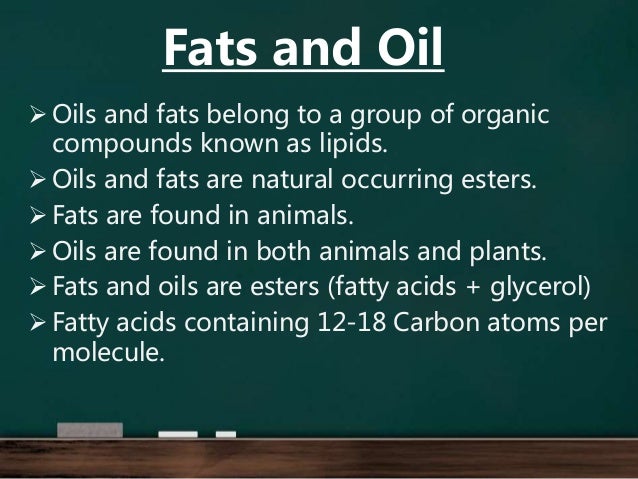Back to: CHEMISTRY SS3
Welcome to class!
In today’s class, we will be talking about fat and oil as higher esters. Enjoy the class!
Fat and Oil as Higher Esters

Sources
Fats are solids that usually come from animals e.g. Tallow (mutton fat). Oils are liquids that come from plants e.g. vegetable oil, coconut oil etc. Both fat and oil are esters of the trihydric alkanol (propane -1, 2, 3- triol).
Physical properties
- Fats have higher melting points due to the presence of a higher proportion of esters of saturated fatty acid.
- Oils have lower melting points because of the presence of esters of unsaturated fatty acid.
Chemical properties
- Hydrogenation of oils: This is carried out in the presence of nickel as a catalyst at 1800C to yield margarine.
- Saponification: Hydrolysis of fats and oils with canotic alkali yields propane-1,2,3-triol and fatty acid of sodium or potassium.
Uses of fats and oil
- Fats are consumed as food.
- Oils are used to make margarine.
- Tallow (a fat) is used for making soaps.
- Groundnut oil and cottonseed oil are used for cooking.
- Coconut oil and palm oil are used for making soap and for cooking.
Evaluation
- Identify two (2) uses of fats and oils.
- Write two (2) chemical properties and two (2) physical properties of fats and oils.
Detergents
Detergents are any substance which has the ability to clean an object e.g. soaps, soap powders, washing liquids and water.
Types of detergent
- Soapy detergents: This is a soap of sodium salt of fatty acid.
Preparation
Animal fat or vegetable bits are steam-heated with sodium or potassium hydroxide in a large container. A concentrated Nuel solution is added to decrease the soluble of the soap – so that it comes out as hard cake on cooling known as salting out.
Structure
CH3(CH2)16 COOCH2
CH3(CH)2)16 COOCH + 3NaOH
(Sodium Hydroxide)
CH3(CH2)16 COOCH
Propane1,2,3-triyltrioctadecanoate
Nature of soap
Each molecule of soap has long hydrocarbon chain (alkyl) which is attached to the ionic head of either COO– Na+ or COO–K+. The alkyl tail hydrophobic) dissolves oil or organic solvent while the ionic soluble in water (hydrophilic).
The action of soap (Cleansing action)
When a soap solution is applied to a grease-coated piece of fabric, the soap molecule moves to the grease spot. The hydrophobic tails dissolve in grease while the hydrophilic dissolves in the water.
The grease spot is lifted up and more soap particles dissolve the grease.
- Soapless detergents: Soapless detergents are the more favoured all-purpose cleansing agents nowadays. They are available as liquids or solids. The example of soapless detergent is alkyl benzenesulphates (ABS). These are sodium salt of an acid e.g. sulphonic acid.
Structure
The molecule of detergent has a hydrophobic tail and a hydrophilic head.
The hydrophobic tail is a long chain hydrocarbon or benzene ring with a long alkyl group.
The hydrophilic unlike soap can be positive or negative change or neutral. The high solubility of soapless detergent in water is due to the presence of –SO3– Na+ in the molecules.
The soapless detergents are called synthetic detergents. The raw materials are petrochemicals from refining crude oil.
Hydrophilic
R – SO3– Na+
Hydrophobic tail
R is a long hydrophobic chain.
The action of soapless detergent
They do not form scum or react with hydrogen ions.
General evaluation
- Draw the structure of soapless detergent.
- State one advantage of soapless detergent over soapy detergent.
Reading assignment
New School Chemistry by Osei Yaw Ababio pages.509-514
Weekend assignment
- The structure of soap according to the saponification process is A. CH3(CH2)16COONa B. CH3CH2COOCa C. CH3CH2CH2COONa D. C2H5COONa
- The example of soapless detergent is A. alkyl B. ethyl ethanoate C. alkanol D. alkylbenzene sulphonates
- The hydrophobic tail of soap dissolves in grease while hydrophilic dissolves in A. benzene B. water C. propanol D. kerosene
- Fats and oils belong to a general group of compounds known as ……….. A. glycerol B. soap C. margarine D. lipids
- Hydrolysis of fat and oil to yield alkanol and soap is called ………… A. esterification B. hydrogenation C. hydrolysis D. saponification
Theory
- Explain the structure of soapless detergent and its mode of action.
- Explain the following; (a) saponification (b) hydrogenation
In our next class, we will be talking about Natural and Synthetic Polymers. We hope you enjoyed the class.
Should you have any further question, feel free to ask in the comment section below and trust us to respond as soon as possible.
